Safety First: MCA Certified
Unlike most other yachts offered for charter, Regina Laska is coded by the MCA. Cruising in Safety, Comfort and Style is a commitment, where Safety plays the major roll.
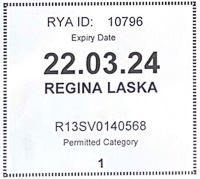
If you are like me and consider safety being paramount, read this carefully. There are a lot of boats offered for charter on the market with more or less experienced skippers. But only a very few of these fulfil the stringent rules for safety. Many follow the standard recommendations of the corresponding home country of the owner for private leisure crafts or they sail under “racing rules”.
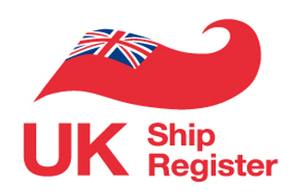
In commercial shipping, The UK Ship Register has become 1 of only around 20 in the world to keep the United States Coast Guard (USCG) award for excellence.
Heavy tradition and nautical history spread their wings over Regina Laska, when joining one of the oldest registrations for commercial ships in the world, dating back from from the 16th century!
In addition to this, Regina Laska is also inspected by the Royal Yachting Association (RYA), so, really, Regina Laska is inspected twice by two individual bodies, the MCA and the RYA. They both look very closely on safety, while the RYA also checks comfort, cleanliness and customer treatment.
I am very proud of the safety standards of Regina Laska!
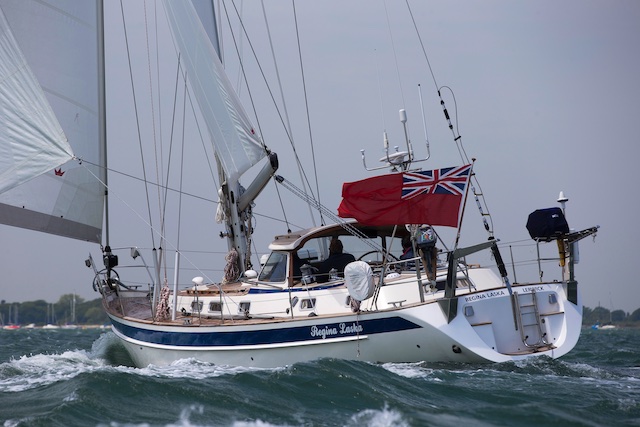
Proudly flying the UK red ensign showing that Regina Laska is under the stringent rules of a proper ship’s register for commercial sailing and coded by the MCA.
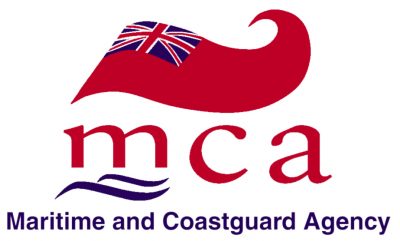
Assess the following when comparing different charter offers:
Regina Laska is surveyed by the MCA following the stringent MGN-280 rules for Area-1 offshore sailing. It’s like the ISO-Quality in boating or the TÜV/MOT for cars.
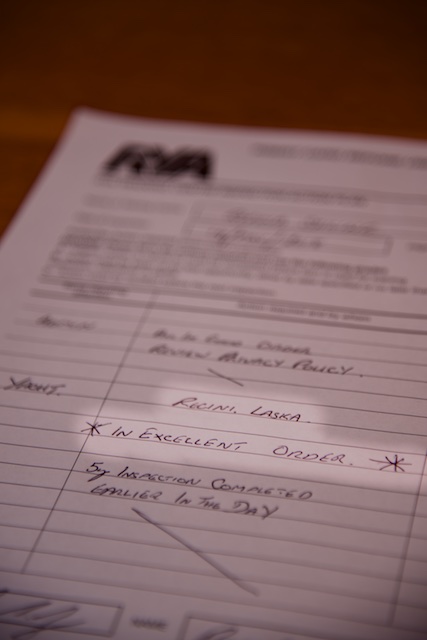
The outcome of one of my MCA inspections (2018).
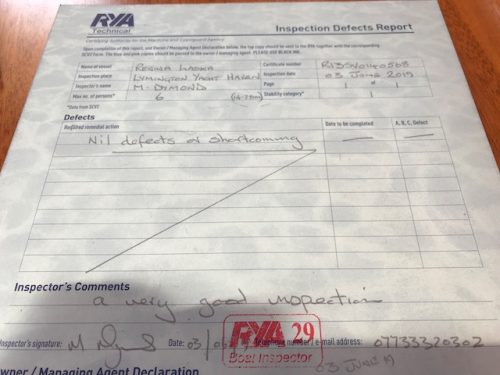
The outcome of my MCA inspection another year (2019): “Nil defects or shortcoming”

The outcome of my 2019 RYA Inspection: “Overall very good administration throughout. Very good inspection. One of the best equipped yachts I have seen. Nil defects”.
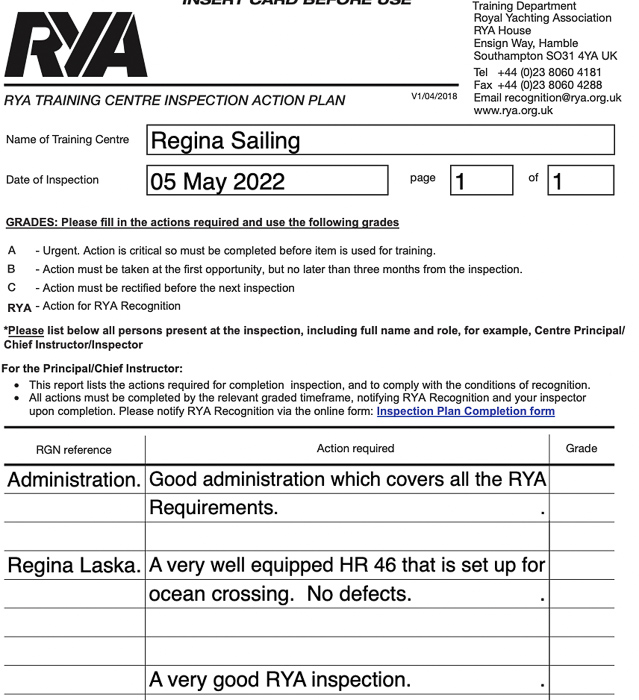
The inspection in 2022. Another consecutive year with nil defects passing the stringent inspection with no problem.
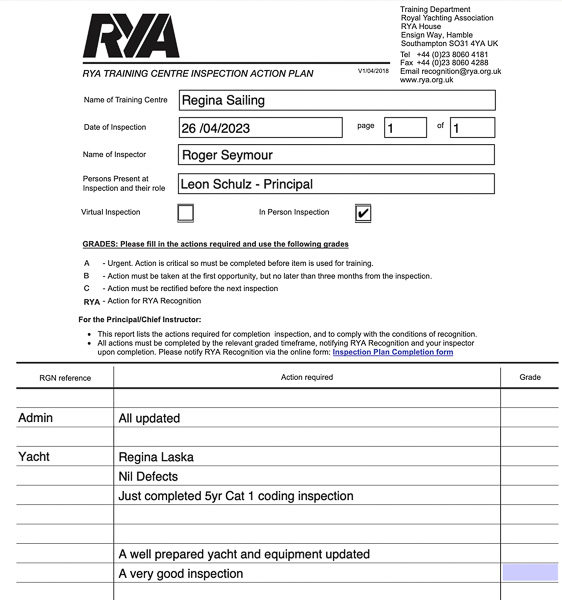
The RYA Inspection 2023. Very happy to have renown Roger Seymour as my inspector, none less than the author of best-selling Yachtmaster book “Yachtmaster for Sail and Power: A Manual for the RYA Yachtmaster® Certificates of Competence”
The extremely high standards of safety must be fulfilled for offshore sailing at all times, which is checked annually by the MCA and the RYA. Charter guests do not notice the rigorous safety measures (and don’t need to think about it either) but might find it re-assuring that the safety standard of Regina Laska is very far reaching and not comparable with most other bare boat charter companies. Every hatch, every pipe, every air ventilation system, every cable follows the stringent rules of the MCA area 1.

My MCA Inspector for 2018 is Julian Smith, Hallberg-Rassy survey specialist flying around the world to survey Hallberg-Rassy boats. Few know HR’s so well as he does (including all the points that possibly need to be looked after and fixed on an HR)
Despite Regina Laska being lifted every winter anyhow, undergoing her annual thorough refits, the boat needs to be lifted for the MCA at regular intervals to be checked also under her waterline. In 2018 it was time again, so I asked the best and most knowledgable surveyor I know for Hallberg-Rassy boats, namely Julian Smith from Hamble Marine Surveys. Julian is, by the way, also a very good address, if you are planning to buy a use HR and wish to have an official survey done.
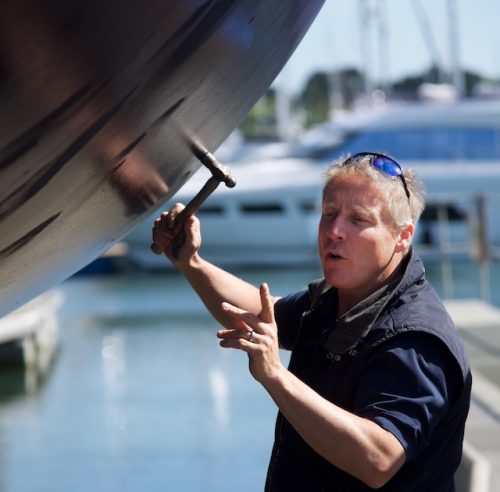
Julian going through the entire hull looking for sound differences that could be tell-tales of a faulty hull.
Julian checked Regina Laska in every detail, looking for delaminations, the state of the through-hulls, the rudder shaft, the cutlass bearing etc. He is especially critical to through-hulls in brass and says they have a planned-for service life of no more than five years. They might hold longer, but how do you know? With brass you know and therefore he would strongly advise any safety-oriented boat owner to to change his through hulls if they are older than 5 years to either bronze or composite, e.g. from True Design. Even on Hallberg-Rassy’s that have not changed their through-hulls, he is not happy with them if they are older than 5 years. Of course, mine are of bronze and will be good for at least 10 years.
Another important issue is groundings, but here, Hallberg-Rassy’s are obviously one of the most sturdy designs on the market. Julian also stresses that newer boats are better built in that respect that today, we know much more about GRP and raisins. Just the right amount of raisin is injected allowing for lighter boats, yet stronger, since the fibres of the glass are put in a stronger way. So, new boats are not necessarily weaker despite the lack of GRP thickness. Rather the contrary, although I must confess that I like the feeling of having a couple of extra mm in hull thickness when sailing far offshore. But that is just a feeling…
The rig has to be inspected every 5 years with a rig inspection report and he was very pleased that I have my rigg checked every or every second year with adequate paperwork. Ever 10 years I change my rigging on Regina Laska.
Julian was especially impressed by how beautifully carbon was spliced into Dynema on my rigg. The credit goes to my rigger Daniel Engström at Spinsail back in Sweden.
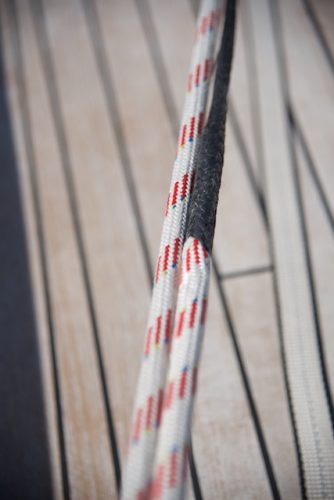
Carbon spliced into Dynema on Regina Laska, made by Daniel Engström at Spinsail, Sweden.
Regina Laska is, however, not only inspected annually by the MCA for Offshore Sailing (area-1), but also by the RYA. The RYA is partly looking at similar issues regarding the safety of the boat, but is also checking how guests live, are treated, if there are complaint possibilities, data protection, tidiness and, obviously, the skipper’s proficiency regarding his own health, his medical training, his up-to-date Yachtmaster Instructor abilities etc. They look at environmental issues and teaching facilities.
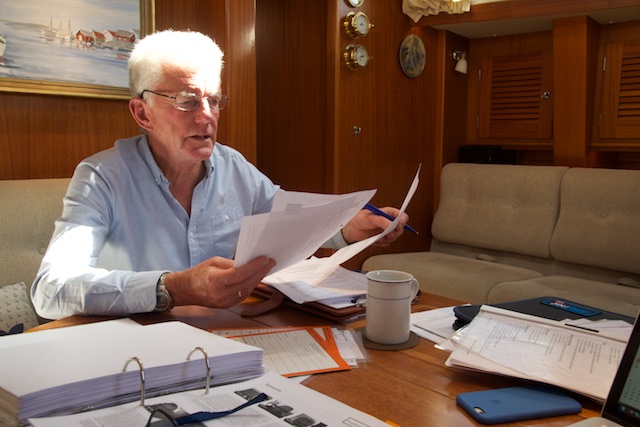
My RYA inspector Roger Seymour inspecting my paperwork before going through the boat in great detail. He also gives tips about new developments within the RYA and what is important to the RYA.
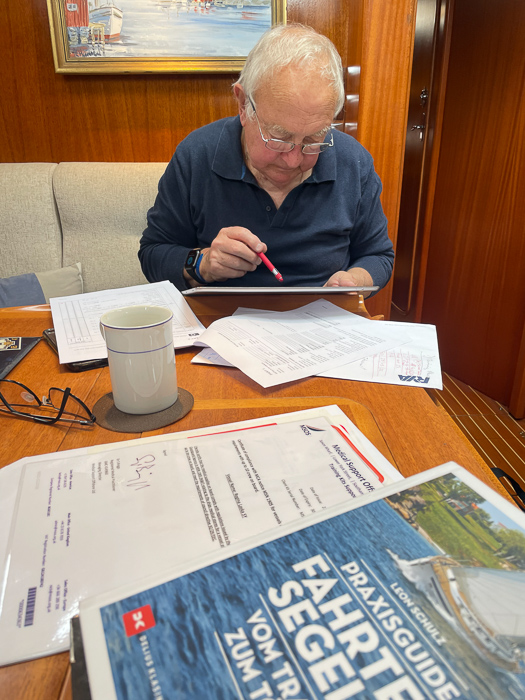
My MCA inspector for the 2022: Mike Dymond going through the list of all items to be checked on Regina Laska, not leaving out any detail to be inspected!

MCA-inspection 2023: Flying in Darren Bartlett from Palma de Mallorca to La Coruña for the major 5-year out-of the water inspection. Again: NIL defects found.
The medical kit onboard is far-reaching and surpasses the newest updated stringent rules of MSN1905 (previous MSN1768) by far. I even cary a defibrillator as well as an oxygen generator.
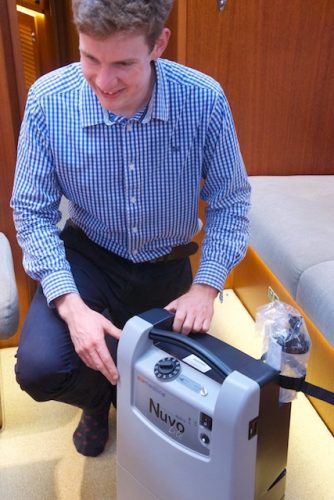
The new oxygen generator is demonstrated by Ben from my medical supplier MSOS.
The medical equipment and all medicines are supplied by Medical Support Offshore (MSOS) . This highly successful company is also supplying a large number of Superyachts, the Volvo Ocean Race (now “Ocean Race”), the Oyster Around The World Rally and numerous private bluewater sailors. The owner and CEO Dr. Spike Briggs is also the co-author of the newest 23rd edition of “The Ship Captain’s Medical Guide” boot that every commercial vessel in the world needs to carry and is also on the board for the MSN1905, deciding what needs to be carried onboard commercial ships.

Ben (left) and Spike (right) during a pleasant dinner at the Haven Restaurant in Lymington, when they came and visited me onboard Regina Laska with personal delivery of the updated medical equipment for Regina Laska in 2022.
I have long been thinking of also adding a Defib onboard. For this reason, I studied a Research Paper from the USCC spanning 11 years of data, ranging from 2000 to 2011.
Checking the statistics, it says that only two persons (1.4% of the cases) died because of cardiac arrest on a motorised sailboat (i.e. no dinghy). Question is, if these two could have been saved if they had a Defib at hand? We are talking about 2 cases in the entire USA during 11 years. In one year alone (2011) the USCC estimated that there werer 16.9 Mio sailing person-days in US waters. For the period, 229 Mio sailor person-days were assumed for the study during the 10 years.
So: 2 dead on motorised sailing boats plus 4 dead on nonmotorised sailing boats (dinghies) died in cardiac arrest during 229 Mio sailor person-days. The risk is thus 6/229Mio = 3 x 10-5 cardiac arrests per 1000 person sailing days or 0.03 cardiac arrests per million sailing days. Sounds as safe as flying to me….?
In 2022, however, I decided to add a Defib despite the above statistis. Better safe than sorry and this way, I can at least say I have tried everything possible. A Defib is not part of the MSN1905 rules, however.
The oxygen generator makes much more sense, and thus I carry one onboard, just to be on the safe side.
Guests who have participated in my Medical Training Courses appreciate to check the equipment and do some onboard medical training as part of their Yachtmaster Training.
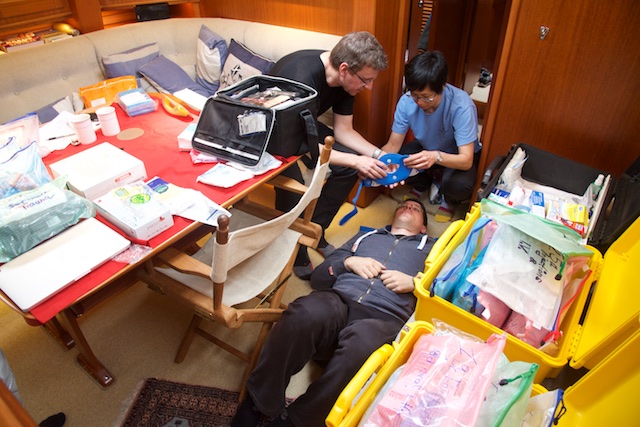
Checking my medical equipment during one of the Yachtmaster Trainings.
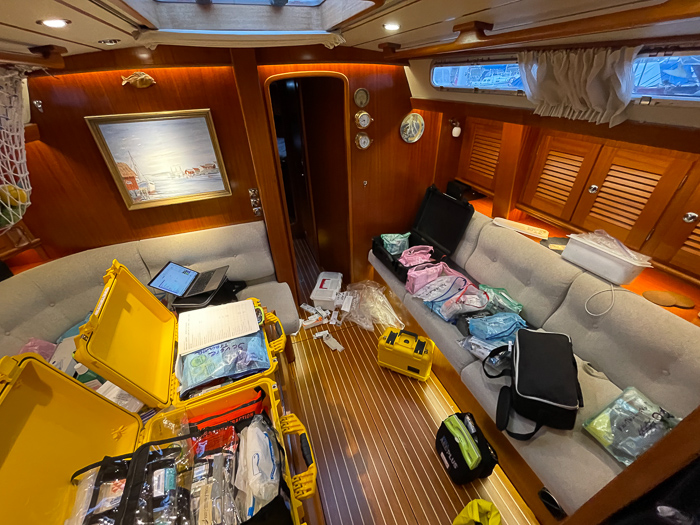
Adding and sorting all my medical stuff, migrating from myself keeping track of all the medicines and tools to letting MSOS take care of it from now on.
To sum up, one can say, the MCA looks after safety, the RYA looks after comfort and I personally look after style!
Some examples that I have to comply with:
- All nine high-end automatically inflatable Spinlock life wests with 3 lights (of which one SOLAS approved), spray-caps and AIS emergency position beacons (PLB’s) are tested and repacked annually by a professional survey station.
- Thermal Protective Aids (TPAs) are available for all onboard.
- The life raft is inflated, repacked and checked annually (and not every 4 or so years as stated by the manufacturers). The life raft is not a standard ISO or ISAF-raft, but follows the strict rules of SOLAS-A (Safety of Lives at Sea), similar to the rafts used by ferries, cruise ships etc.
- The life-raft as well as one of the two EPIRB’s are equipped with a Hammar H20 hydrostatic release unit. Check the video i made how to fit it correctly.
- The propane gas system is completely regularly replaced (e.g. 2013 and 2022) and essential parts replaced are exchanged in between (e.g. all hoses every 4 years). The gas system is surveyed annually by a gas expert. The installed gas alarm does not only given an alarm sound, but also automatically shuts of the gas at the bottle, which is stored in a ventilated deck storage.
- There is an CO (Carbon Monoxide) alarm installed
- Alarms for high bilge water including an automatic bilge pump is installed
- There are 5 bilge pumps onboard: One running on 230V, two on 24V, one on the 12V emergency power system and one manually operated high capacity pump.
- There are 4 smoke detectors and 8 fire extinguishers of various sizes and fillings, including one for Lithium-fires. They are serviced annually.
- Fire buckets and a fire pump (to pump water from the sea) and a long hose also part of the fire safety system.
- There are 5 flash lights strategically placed around the boat (e.g. over each cabin door) in addition to a large number of flashlights and search lights in drawers and cabinets. Many of the flashlights are watertight and glow in the dark to be easily found.
- – The engine room is fully fire proof, has its own fixed CO2 extinguishing system and dedicated fire-alarm.
- – The boat is built according und under the supervision of Germanischer Lloyd and carries the GL 100-A5 certificate
- – The entire boat has undergone a rigorous individual stability test and carries a Stability Booklet proving its seaworthiness under all conditions of loading and wind forces. A Freeboard Mark is existent.
- – Regina Laska has three individual electrical power systems (24V, 12V and 230V) whereby one solely dedicated as emergency power system for essential lighting, navigation and communication (12V). The main batteries are of the modern Li-Fe type (new 2018) and will always offer ample power. The generator and power chargers and inverter are regularly replaced for safety reasons (e.g. 2013 and 2022)
- – There are three independent heating systems onboard, two by Webasto and one by Ebersprecher on the main engine.
- – A lighting protection system is installed to protect crew and guests against lighting storms
- – There is a comprehensive 215 pages long Operating Procedure Manual that is valid for Regina Sailing, including a specific Risk Assessment Plan for the operation in order to keep you safe onboard.
- Strategically placed and luminous IMO-standard signs show where essential emergency equipment is stored and show the way to the nearest exit. They glow in the dark.
- Reginasailing is using a Yacht Management software by Aquator Marine to keep track on tasks and organise the safety of Regina Laska.
- The operation is supported by an extensive documentation, such as a Training Manual, an Instruction Manual, a Defect Booklet, an Accident Reporting Routine and numerous Safety Checklists and Nautical Publications. These are all annually checked by the classification society.
- There are several sophisticated MOB-systems onboard, e.g. the Jonbuoy Recovery System by Ocean Safety (new 2018, annually serviced and checked), fixed horseshoe buoys and Danbuoys with light as well as a SwedeBuoy Recovery system.
- There are three MOB-Lines carried on deck for quick line throwing
- Many regular Reginasailing crew members are joining up and participate at various safety and emergency training courses. This is not only fun, but enhances the safety when they join on a leg. See here about Reginasailing crew safety training.
- There are three anchors onboard: A 40kg Rocna with 80m stainless steel stress-tested chain, plus a Fortress FX85 (also used as the main anchor by the US coast guard for its 87 feet/91 tonnes ships) as storm anchor plus a Bruce 15 kg kedge.
- The navigation system is the latest Furuno-equipment and is redundant in all major aspects, e.g. with two plotter/PC systems, two autopilots, four fixed GPS’s plus two handheld ones (one in grab-bag and one stored protected against lighting). Further to the annually deviated main compass, there are three electronic heading sensors onboard (one satellite compass plus two electronic fluxgate compasses). In addition to the two redundant navigation systems, we use SeaPilot with official S-58 ENC charts, which is connected to the onboard navigation system via a Multiplexer.
- Charts and Guide books are up to date
- Celestial navigation is used for fun and safety, should there be a lighting strike or a hacking into the GPS-system.
- The state-of-the-art communication equipment consists of two types of satellite communication equipment (Iridium plus Inmarsat), Sailor SOLAS classed MF/HF SSB with DSC shortwave radio and four VHF-radios (one fixed with three receiver stations onboard, plus three handheld radios, of which one is a SOLAS classed GMDSS radio for the life raft). Emergency transmitting units are: Two 406 MHz EPIRBs, one SART (Search and Rescue Transponder) plus the above mentioned VHF with DSC, GMDSS MF/HF with DSC (medium frequency and high frequency via SSB), Inmarsat C, Iridium Satphone and the three handheld VHFs
- Further to 900 liters of water in the tank and emergency water bottles, Regina Laska has two watermakers: One 145L/h high capacity watermaker and one emergency hand-driven watermaker. Emergency food and water rations are is also carried, both in bottles onboard as well as in the SOLAS-A liferaft.
- Each cabin has two exits, one through the door and one through an individual hatch. The way out is clearly marked with glowing signs. This is seldom found on production boats these days, unfortunately, where many cabins only have a window or a far too small hatch that could not be used as an exit in case of fire.
- The dinghy is a RIB (Rigid Inflatable Boat) providing save and comfortable transportation from and to the anchored Regina Laska. Special handrails and side ladders provide safe and comfortable boarding
- The dinghy is carried in Davit and not on deck, where it would block the emergency exits from the cabins
- The ship’s medical store carried onboard fulfil the stringent rules of MSN1768 for area 1 offshore sailing and are annually checked and updated by a dedicated pharmacy familiar with stocking up medical stores on commercial ships
- The skipper regularly renews his safety training where the 14 days safety training includes a 9 days intense medical care course in accordance to STCW (IMO’s Convention on Standards of Training, Certification and Watchkeeping for Seafarers)
- The skipper has the qualification of an RYA Yachtmaster Ocean instructor (renewed and assessed every 5 years) and has sailed well over 70,000 miles for more than 40 years and has over 10 years of experience in professional charter- and sail training.
The above safety equipment are some examples to illustrate how Regina Laska is operated and how she differs from most boats used for bareboat or skippered charters or sail training vessels. They will hopefully never be used and hardly be noticed by most guests. It’s just a good feeling that safety is playing an equally important roll as on a cruise ship or ferry.
Before joining any charter or sail training boat you might consider or fancy, I would strongly recommend to require that the boat as well as the skipper’s qualifications follow the MCA or any other respected society. Ask to see a certificate stating the area the boat is allowed to sail in – and not just under racing rules. And even if the boat fulfils national rules, it is good to compare these to the stringent MCA MGN-280 rules. The fact that a skipper has many years of experience or has sailed many miles is good, but would not be sufficient if the vessel is coded by the MCA, which has very stringent rules on the skipper’s regular assessments and examinations, keeping up with the commercial endorsement which is necessary if you skipper with paying crew.
The fact that the boat would be insured for a wider area is not relevant, since an insurance helps little when the actual situation strikes.
MCA SCV CERTIFICATE – REGINA LASKA
MCA Stability Booklet – REGINA LASKA
RYA Yachtmaster Ocean Instructor certificate of your skipper Leon
